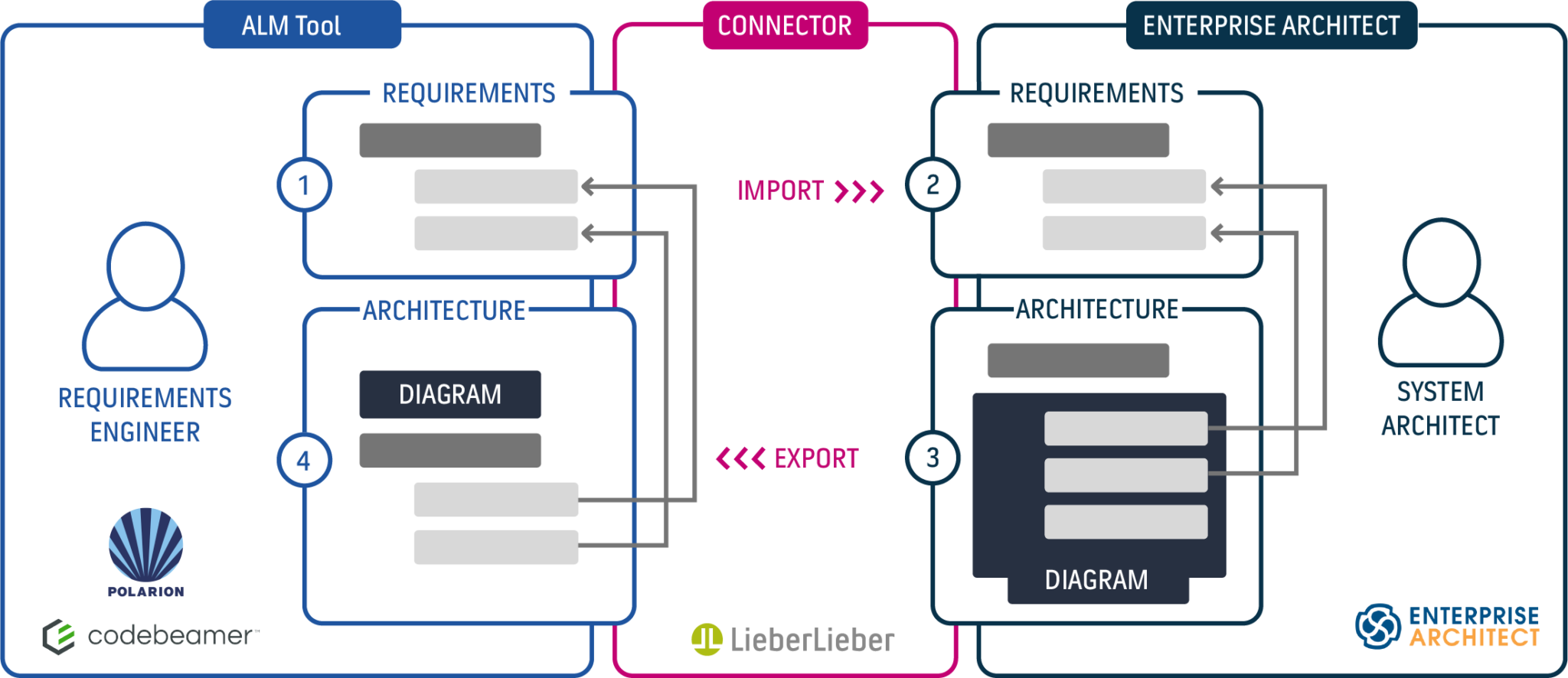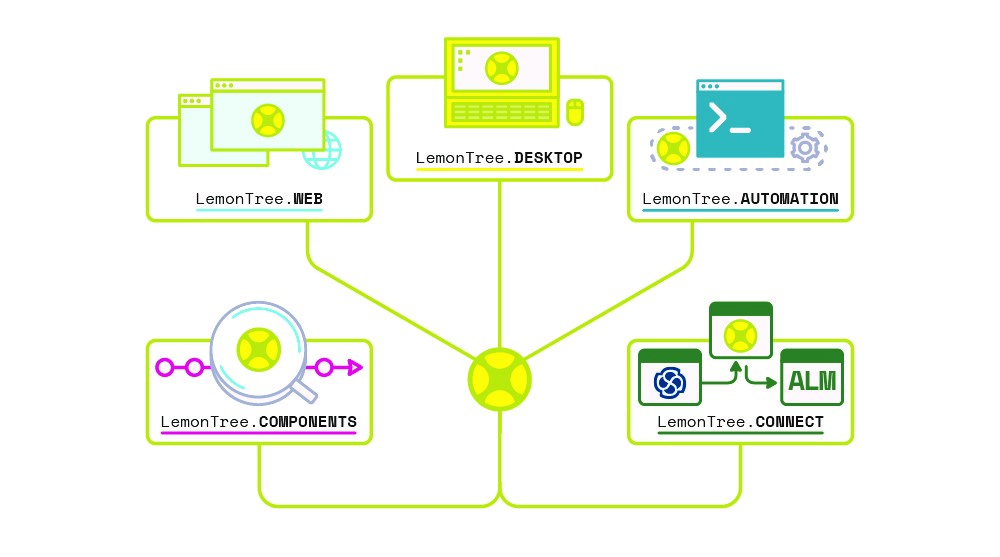LieberLieber launched its product LemonTree more than six years ago. As the demand expanded more and more, LemonTree has become a product family in the meantime. An important part of this is the LemonTree.Connect product group, which connects various ALM systems with Enterprise Architect. It currently consists of two connectors and could grow to three by the end of the year.
Vienna – The most important function of LemonTree when it was introduced was the comparison and merging of different model versions. The 3-way comparison algorithm used for this takes into account the graph structure of the models and thus allows an accurate comparison between two versions. The complete modernisation of the data access layer then created a new technical core for LemonTree that enables today’s developments.
Meanwhile, the LemonTree family consists of the following products:
- LemonTree.Desktop: Diff/Merge functions
- LemonTree.Web: Functionality like LemonTree.Desktop, available as web application via browser
- LemonTree.Automation: use in the context of a build server pipeline (without GUI)
- LemonTree.Components: Allows the division of a model created with Enterprise Architect into different sub-models or components.
- LemonTree.Connect: Synchronisation of ALM tools (Codebeamer, Polarion) and Enterprise Architect
Dr. Konrad Wieland, CEO of LieberLieber: “We are very pleased about the great demand for LemonTree. Since our product now allows for different application scenarios, we have decided to expand LemonTree into a product family. Our modern data access layer allows us to offer a wide range of variations with the highest performance. This allows us to meet the wishes of our customers and to further facilitate and deepen the handling of models. In doing so, we see ourselves as a partner of the industry, which today faces challenges that have not existed before, not only regarding complexity.”

Dr. Konrad Wieland

The LemonTree.Connect Workflow
Manage models over their entire life cycle
The LemonTree.Connect product group connects ALM systems with Enterprise Architect and at the moment consists of two connectors (codebeamer, Polarion).
Currently, LemonTree 3.3.1, LemonTree.Connect codebeamer 2.6.0 and LemonTree.Connect Polarion 1.2.0 are available. Both connectors belong to the LemonTree product family as they are based on the same technology. During import and export, a comparison is made and the difference is calculated so that only this is transferred during synchronisation to improve performance. The main focus of both integrations is the exchange of traceability information (references) between the two worlds of ALM and Enterprise Architect (UML/SysML).
Tools for application lifecycle management (ALM) support the entire lifecycle of software from design to maintenance. They quickly and clearly show which requirements have already been taken into account in the software. By connecting to the Enterprise Architect modelling platform, system architects and engineers can create accurate models based on the requirements. At the same time, it is ensured that these requirements are covered by the models and that the effects of changes to requirements can be easily determined. Wieland: “Modern development processes are driven by more and more data, which is often maintained in different systems. Therefore, it was clear to us that we should build a powerful link between the modelling world and requirements management. This opens up the benefits of both worlds to users, allowing them to manage growing complexity while maintaining a high level of flexibility.” LemonTree.Connect basically works as a connector even without a LemonTree licence. However, if the LemonTree functions are activated, then many additional possibilities arise that make the daily work with the models much easier.
LemonTree.Connect closes the loop between requirements and model artefacts in an MBSE environment. This enables users to easily monitor and manage complex product development processes, even in highly regulated industries.
Model parts for the supply chain
In many sectors, such as the automotive industry, the companies involved in the product development process today often see themselves as elements of networked supply chains that continue to become more and more complex. Therefore, a product like LemonTree, which is used at a very central point of model-based development, must also meet these requirements. With LemonTree.Components it is possible to detach model parts or components from a model and make them available to suppliers for further development. Once external development is complete, the component can be easily reintegrated into the model. Conversely, developers at suppliers or from other internal departments can import predefined model packages into Enterprise Architect for further development. In addition, model parts can be defined as “read-only” so that a supplier can use these parts but not modify them.
Connecting LemonTree.Components with LemonTree.Automation
In order to operate lifecycle management for parts or individual components of a model created with Enterprise Architect, the model must be split up. The resulting sub-models can then be maintained individually. LemonTree.Components makes it possible to specify parts of an Enterprise Architect model as reusable components and to separate them from the model. These components can then be edited as an independent model, versioned and reloaded into the overall model.
LemonTree components are extracted from the model via export and imported into another model via import. This restricts distributed editing to specific parts of the model. With LemonTree, differences in the edited components are quickly recognised and visualised. After adjusting the component in a so-called working model, the changes are integrated back into the original overall model.
Depending on the working method, the overall model is regularly updated and a new revision of the components is imported. This task is taken over by LemonTree Automation, integrated in a build server pipeline. In this way, models are integrated into familiar processes and changes remain visible and testable.
An example workflow for this procedure was recently presented in the white paper: “LemonTree Automation – How to work successfully with LemonTree Components in a build pipeline using version control” (see info box).
More information about LemonTree.Connect
Changelog LemonTree.Connect codebeamer 2.6.0:
Download LemonTree.Connect codebeamer:
Download LemonTree.Connect Polarion:
Further information can be found on the help pages for the two connectors:
https://help.lieberlieber.com/codebeamer.html
https://help.lieberlieber.com/polarion.html
Find the appropriate training for the optimal use of LemonTree:
Whitepaper: LemonTree Automation
The workflow presented in the new whitepaper “LemonTree Automation – How to work successfully with LemonTree Components in a build pipeline using version control” shows one way to work with LemonTree.Components and LemonTree.Automation in the context of a build pipeline. By exploiting all the possibilities of the tools, an extensive tool chain is created, which can be realised in different stages of expansion depending on the requirements.
In principle, Enterprise Architect models can be managed in version control systems and thus used in a build pipeline. One problem, however, is that under certain circumstances a monolithic overall model is versioned that consists of different, independent components. To solve this problem, the model is split into LemonTree Components and each component is managed in its own version control repository (called Git Repository in this example).
AUTOSAR-UML Bridge
LieberLieber and IncQuery have a long-standing partnership in the area of model-based development with Enterprise Architect and LemonTree. This collaboration has now resulted in the AUTOSAR-UML Bridge by IncQuery, a powerful solution for bridging the gap between AUTOSAR and UML. It enables developers to streamline the development process and improve the overall efficiency of system design.
The IncQuery AUTOSAR-UML Bridge is tightly integrated with LemonTree. This integration allows automotive systems or software engineers to use LemonTree’s capabilities to easily track AUTOSAR changes by re-importing and securely merging them into the Enterprise Architect UML project. This way, UML stakeholders can stay on the same page for each project iteration without wasting time on manual reviews and data entry.

